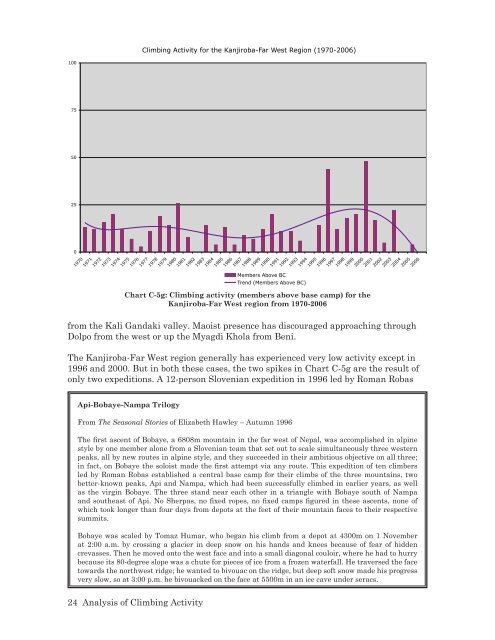The Himalaya by the Numbers: A Statistical Analysis - Himalayan ...
The Himalaya by the Numbers: A Statistical Analysis - Himalayan ...
The Himalaya by the Numbers: A Statistical Analysis - Himalayan ...
Create successful ePaper yourself
Turn your PDF publications into a flip-book with our unique Google optimized e-Paper software.
100<br />
75<br />
50<br />
25<br />
0<br />
1970<br />
1971<br />
1972<br />
1973<br />
1974<br />
1975<br />
1976<br />
1977<br />
Chart C-5g: Climbing activity (members above base camp) for <strong>the</strong><br />
Kanjiroba-Far West region from 1970-2006<br />
from <strong>the</strong> Kali Gandaki valley. Maoist presence has discouraged approaching through<br />
Dolpo from <strong>the</strong> west or up <strong>the</strong> Myagdi Khola from Beni.<br />
<strong>The</strong> Kanjiroba-Far West region generally has experienced very low activity except in<br />
1996 and 2000. But in both <strong>the</strong>se cases, <strong>the</strong> two spikes in Chart C-5g are <strong>the</strong> result of<br />
only two expeditions. A 12-person Slovenian expedition in 1996 led <strong>by</strong> Roman Robas<br />
Api-Bobaye-Nampa Trilogy<br />
From <strong>The</strong> Seasonal Stories of Elizabeth Hawley – Autumn 1996<br />
<strong>The</strong> first ascent of Bobaye, a 6808m mountain in <strong>the</strong> far west of Nepal, was accomplished in alpine<br />
style <strong>by</strong> one member alone from a Slovenian team that set out to scale simultaneously three western<br />
peaks, all <strong>by</strong> new routes in alpine style, and <strong>the</strong>y succeeded in <strong>the</strong>ir ambitious objective on all three;<br />
in fact, on Bobaye <strong>the</strong> soloist made <strong>the</strong> first attempt via any route. This expedition of ten climbers<br />
led <strong>by</strong> Roman Robas established a central base camp for <strong>the</strong>ir climbs of <strong>the</strong> three mountains, two<br />
better-known peaks, Api and Nampa, which had been successfully climbed in earlier years, as well<br />
as <strong>the</strong> virgin Bobaye. <strong>The</strong> three stand near each o<strong>the</strong>r in a triangle with Bobaye south of Nampa<br />
and sou<strong>the</strong>ast of Api. No Sherpas, no fixed ropes, no fixed camps figured in <strong>the</strong>se ascents, none of<br />
which took longer than four days from depots at <strong>the</strong> feet of <strong>the</strong>ir mountain faces to <strong>the</strong>ir respective<br />
summits.<br />
Bobaye was scaled <strong>by</strong> Tomaz Humar, who began his climb from a depot at 4300m on 1 November<br />
at 2:00 a.m. <strong>by</strong> crossing a glacier in deep snow on his hands and knees because of fear of hidden<br />
crevasses. <strong>The</strong>n he moved onto <strong>the</strong> west face and into a small diagonal couloir, where he had to hurry<br />
because its 80-degree slope was a chute for pieces of ice from a frozen waterfall. He traversed <strong>the</strong> face<br />
towards <strong>the</strong> northwest ridge; he wanted to bivouac on <strong>the</strong> ridge, but deep soft snow made his progress<br />
very slow, so at 3:00 p.m. he bivouacked on <strong>the</strong> face at 5500m in an ice cave under seracs.<br />
24 <strong>Analysis</strong> of Climbing Activity<br />
Climbing Activity for <strong>the</strong> Kanjiroba-Far West Region (1970-2006)<br />
1978<br />
1979<br />
1980<br />
1981<br />
1982<br />
1983<br />
1984<br />
1985<br />
1986<br />
1987<br />
1988<br />
Members Above BC<br />
Trend (Members Above BC)<br />
1989<br />
1990<br />
1991<br />
1992<br />
1993<br />
1994<br />
1995<br />
1996<br />
1997<br />
1998<br />
1999<br />
2000<br />
2001<br />
2002<br />
2003<br />
2004<br />
2005<br />
2006


